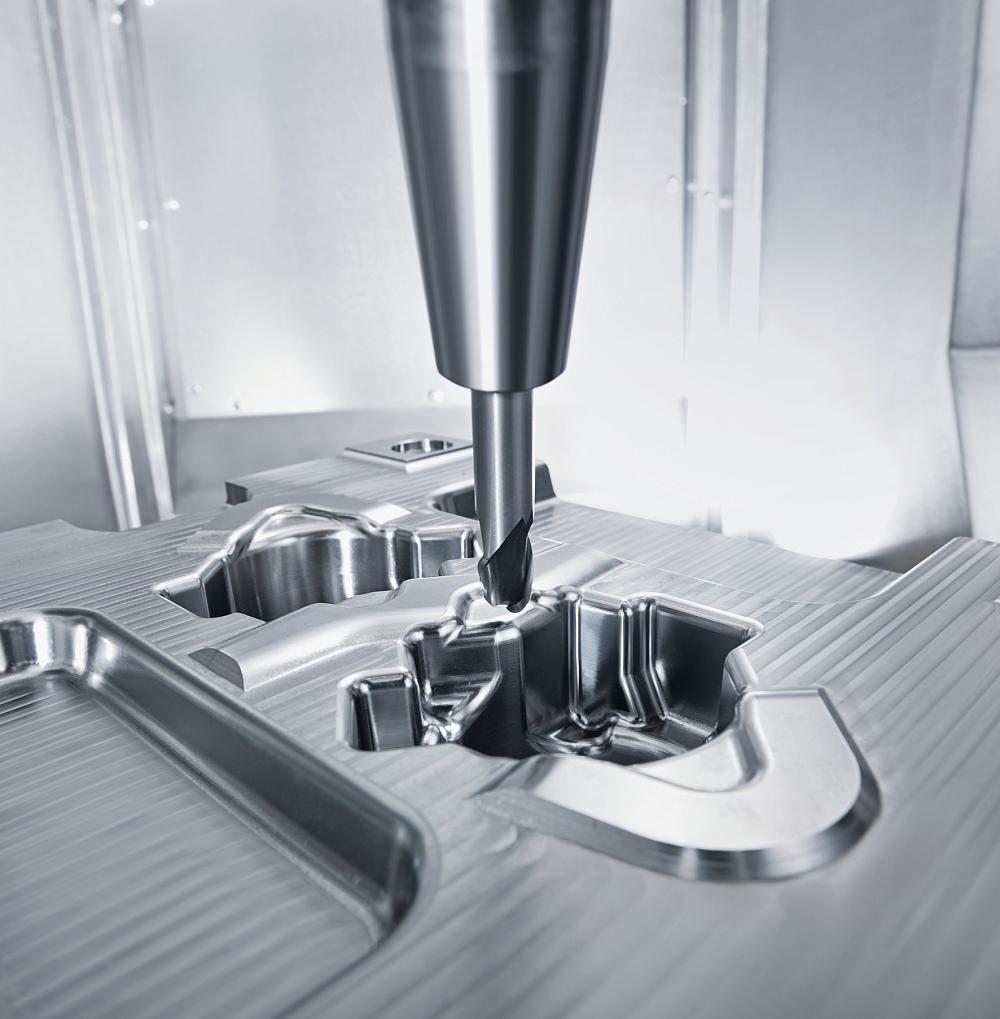- FMA
- The Fabricator
- FABTECH
- Canadian Metalworking
The Need for Speed
High-speed cutting enables high metal removal rates, better surface quality
- By Canadian Metalworking
- July 13, 2016
- Article
- Metalworking
Simultaneous machining with five axes constitutes the elite class of milling technology, especially in machine configurations with high-speed spindles and dynamic direct drives. Markus Rehm, managing director of Deckel Maho Seebach GmbH, a part of the DMG Mori Group, was asked about the ever-growing importance of 5-axis milling in general and high-speed cutting (HSC) machining in particular. Here’s what he had to say.
CM: What makes 5-axis machining technology so interesting?
Rehm: In principle, the key aspect here is the reduction of throughput times. This is the only way that quality-conscious companies can survive today in face of the tough competition on the market.
Five-axis machining gives users a decisive edge, because it enables them to reduce their logistic expenses enormously. Free spatial positioning of tools boosts flexibility in production, and reclamping procedures are reduced to a minimum. The key words here are complete machining in a single setup.
In addition, 5-axis machining has technological benefits that have a direct impact on the quality of the machined surfaces. This can be seen clearly, for example, when cutting an inclined surface. A 3-axis machine would have to machine this in many small incremental cutting steps. With 5-axis positioning, the tool can be positioned at the required angle to this surface and can remove the material in a single step. The result is better surfaces that can also be produced in a shorter time.
CM: How does 5-axis machining result in better surfaces?
Rehm: The free geometric orientation of the tool axis allows the use of relatively short, and therefore also very sturdy, tools. Shorter tools in turn have a positive effect on cutting values and tool deflection. The vibrations on the tool cutting edge are also lower.
As a result, it is much easier to achieve excellent surface qualities and a high level of dimensional and shape accuracy. Another effect is that more stable process conditions with minimum vibrations lengthen the service life of the tools. This sometimes reduces tool costs by up to 50 per cent compared with 3-axis milling.
CM: What benefits can be gained in HSC machining?
Rehm: The strengths of HSC milling machines can be seen on several levels. The high cutting speeds reduce the process forces between the tool and the workpiece. In addition, a large part of the heat generated during HSC milling is dissipated via the chips, and this reduces stressing of the cutting edge or, seen another way, increases tool service life and therefore also process reliability. The lower thermal burdening during the process also has positive effects on the peripheral zone properties of the machined workpieces.
Moreover, the low cutting and passive forces enable fulfilment of higher demands on dimensional and geometric accuracy. High cutting volumes, even in the case of low cutting depths, and the corresponding short manufacturing times, are further advantages. From the quality point of view, HSC milling scores points thanks to its low tendency to burr formation and the surface qualities that can therefore be achieved. Downstream finishing processes are reduced or can even be done away with altogether.
CM: How should shops proceed into 5-axis, high-speed cutting?
Rehm: Five-axis machining with its high degree of freedom enables unlimited spatial manufacturing possibilities with unique geometries and contour features. But the complexity of the application requires both an adequate process chain, from job preparation to the machine, and for employees to have an appropriate level of competence.
Nevertheless, the user that implements this strategic step is rewarded with uncountable benefits – right through to include finishing in a single setup. This allows a company to significantly increase both productivity and the precision of the workpieces.
Even hard material can be machined with maximum precision and best surface qualities using 5-axis machining and HSC milling, so that tool- and mouldmakers can often do away with time-consuming eroding.
CM: Is machine tool technology available to help make all of this possible?
Rehm: Direct drives rank as the perfect basis for high-speed milling, because their rapid traverse, acceleration, and backlash values are in an order of magnitude far above those of conventional drives.
When combined with high-performance controls, a high control quality with a large Kv factor can be achieved, and this in turn enables low servo lag and excellent positioning accuracy even with fast travel speeds.
In addition, direct drives provide high static and dynamic rigidity, because the reverse play and elasticity of the powertrains are eliminated. Contactless power transmission also means that the direct drives operate friction-free without any wear.
Spindles with shaft, flange, and sleeve cooling, as well as the cooling of the machine bed, drives, and guides, are important too.
DMG Mori Canada * 905-795-2891 * www.dmgmori.com
About the Author
subscribe now


Keep up to date with the latest news, events, and technology for all things metal from our pair of monthly magazines written specifically for Canadian manufacturers!
Start Your Free Subscription- Industry Events
MME Winnipeg
- April 30, 2024
- Winnipeg, ON Canada
CTMA Economic Uncertainty: Helping You Navigate Windsor Seminar
- April 30, 2024
- Windsor, ON Canada
CTMA Economic Uncertainty: Helping You Navigate Kitchener Seminar
- May 2, 2024
- Kitchener, ON Canada
Automate 2024
- May 6 - 9, 2024
- Chicago, IL
ANCA Open House
- May 7 - 8, 2024
- Wixom, MI























